Garden Edging Ideas: Best Tree Rings, Stone, Plastic & Eco Tips
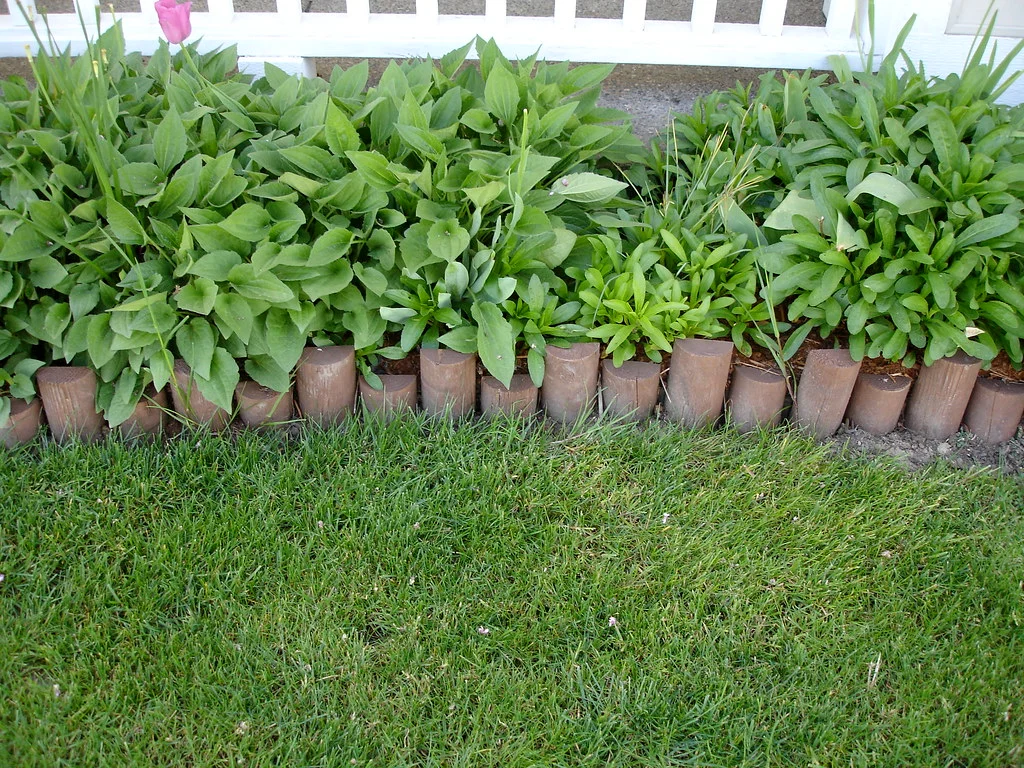
Walking through my neighborhood last weekend, I noticed something that made me stop in my tracks. Two houses, side by side, with nearly identical landscaping — except one looked professionally designed while the other seemed unfinished. The difference? One simple detail that most homeowners overlook entirely.
Sharp, defined borders around every bed and tree.
After twenty years of military precision carrying over into my family life, I’ve learned that the smallest details often make the biggest impact. Whether you’re tackling your first landscaping project or trying to upgrade your curb appeal on a family budget, choosing the right borders for your beds can transform your entire yard. The difference between amateur and professional landscaping often comes down to this one finishing touch.
I’ll walk you through everything from classic tree ring edging options to budget-friendly plastic solutions, plus some eco-friendly alternatives that actually work. No fluff, no sales pitches — just real experience from someone who’s tried most of these options across multiple moves and different climates.
Why Proper Borders Transform Your Entire Landscape
The functional benefits extend far beyond simple aesthetics, though that polished curb appeal definitely matters when neighbors start asking questions. Garden edging keeps your expensive mulch exactly where you placed it instead of washing into driveways and sidewalks during every thunderstorm.
Installing borders creates protective barriers around trees that prevent costly damage from mowers and string trimmers. I learned this lesson the hard way after repeatedly nicking our oak tree’s bark during rushed weekend yard work sessions with six kids running around.
Maintenance becomes dramatically easier when flower beds have clearly defined boundaries. No more guessing where grass ends and plantings begin during weekly mowing sessions. No more accidentally destroying emerging perennials because they weren’t clearly marked.
✅ The visual impact cannot be overstated. Clean, intentional lines give your yard that “finished” appearance that makes neighbors assume you hired professional landscapers — even when you completed the entire project yourself during naptime on Saturday afternoons.
Property value benefits justify the investment for families planning long-term homeownership. According to the National Association of Realtors, well-defined landscaping increases home values by 5-12% depending on regional markets and overall yard design.
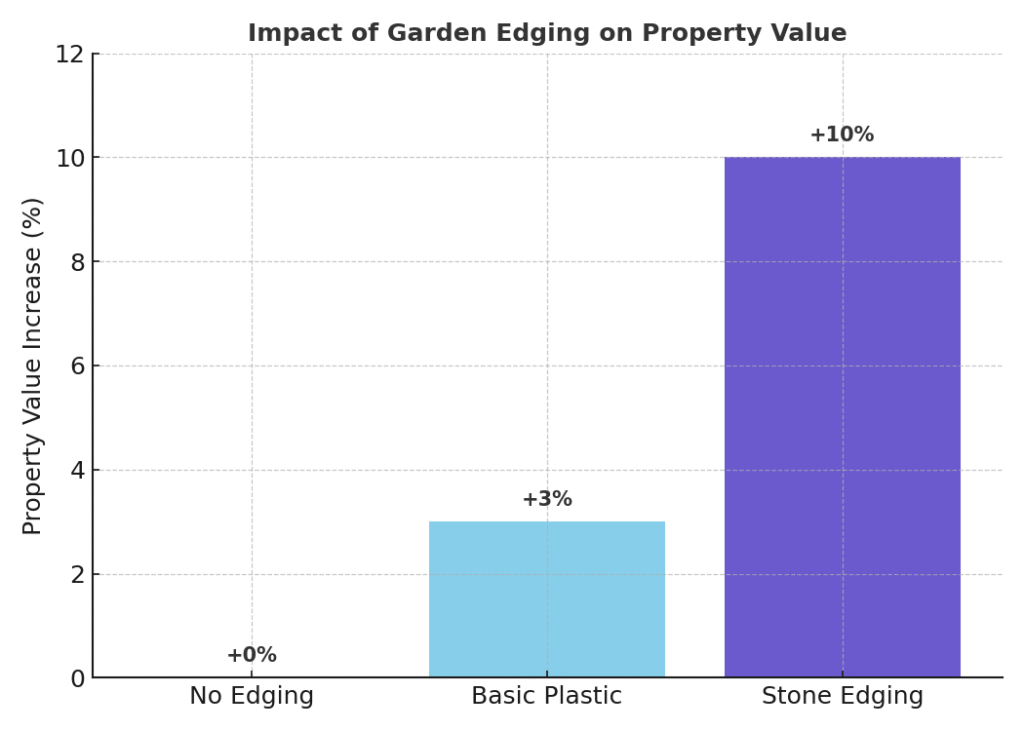
➡️ Weed control improves significantly with proper installation. Defined borders prevent grass encroachment into flower beds while making it easier to apply pre-emergent herbicides precisely where needed without affecting desirable plants.
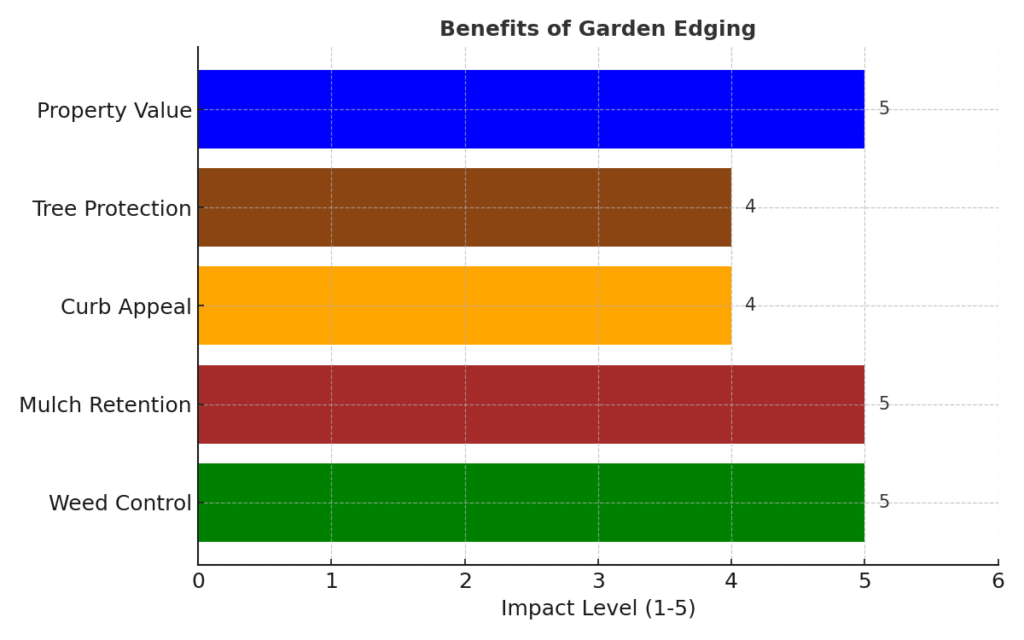
Tree Ring Edging: Classic Protection with Important Caveats
Tree ring edging involves installing circular borders around individual trees, creating defined spaces for mulch application and protection from lawn maintenance equipment. These pre-formed rings come in materials including rubber, steel, decorative stone, and heavy-duty plastic designed specifically for tree applications.
The installation process appears deceptively straightforward — dig a shallow circular trench, position the ring at proper depth, and backfill with soil. Most homeowners can complete installation around a single tree in under two hours with basic tools.
Protection benefits become immediately apparent after installation. The ring creates a consistent buffer zone that eliminates accidental trunk damage during weekly mowing and trimming sessions. Your mature trees will appreciate eliminating those close encounters with power equipment that cause bark wounds and stress.
However, tree ring edging requires careful consideration of proper spacing, drainage, and long-term tree health impacts. Installing rings too close to trunk bases or creating deep mulch wells can harm tree health by encouraging root rot, pest infestations, and improper root development.
🌳 The critical measurement involves leaving adequate space for root flare — that natural trunk widening where above-ground growth transitions to root systems. I made this spacing mistake with our first maple tree, installing the ring too snugly and creating drainage problems that required two full growing seasons to correct properly.
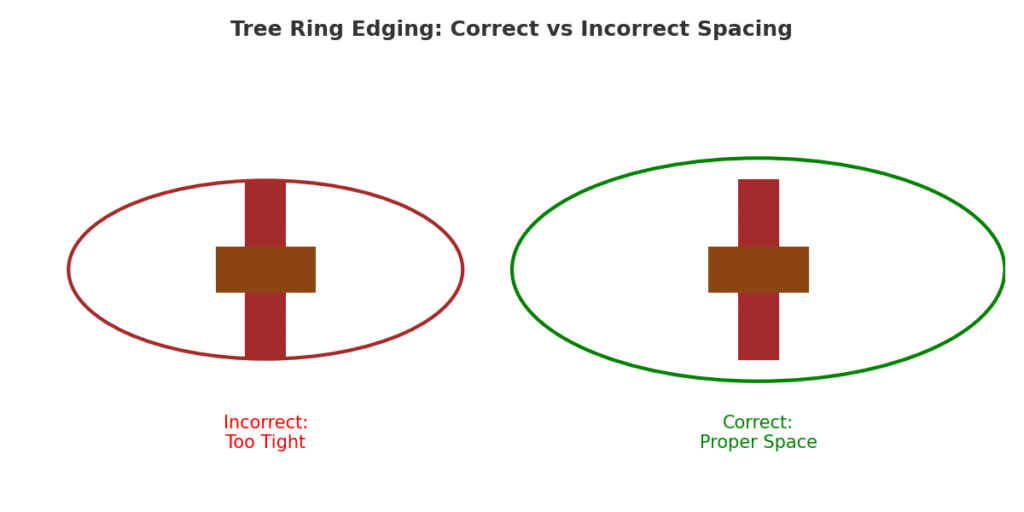
Material selection significantly impacts both immediate appearance and long-term maintenance requirements. Rubber rings offer excellent flexibility and weather resistance but may lack the upscale appearance some homeowners desire for front yard applications.
Steel options provide crisp, modern lines that complement contemporary landscape designs. However, steel can develop rust stains over time and may create sharp edges that pose safety concerns around children’s play areas.
💰 Decorative stone rings offer premium aesthetics but require more complex installation and higher material costs. Natural stone tree rings can cost $50-150 per installation depending on ring diameter and stone selection.
Sizing considerations affect both functionality and visual proportions. Rings that appear appropriately sized around mature trees may look oversized around young plantings, while undersized rings fail to provide adequate protection as trees grow.
Stone Garden Edging: Premium Investment in Lasting Beauty
Stone borders represent the premium choice for homeowners seeking permanent, high-impact edging that enhances property values. Natural flagstone, manufactured concrete pavers, decorative river rock, and cut stone blocks all provide different aesthetic options within this category.
Durability advantages make stone attractive for long-term property investment. Properly installed stone garden edging can function effectively for decades without replacement, unlike plastic alternatives that require renewal every 3-5 years.
Installation complexity requires more extensive planning and physical preparation compared to simpler options. Projects involve excavating deeper trenches, creating level gravel bases, and carefully positioning individual stones for consistent height, spacing, and visual alignment.
The labor intensity cannot be minimized when planning stone projects. Moving and positioning natural flagstone truly constitutes back-breaking work that many homeowners underestimate. I recruited my two older daughters for our front yard flagstone installation — they definitely earned their weekend spending money helping with that project.
📊 Cost considerations extend well beyond initial material purchases. Natural stone typically costs $8-15 per linear foot for materials alone, while professional installation can increase total project costs to $25-40 per linear foot for complex curved designs.
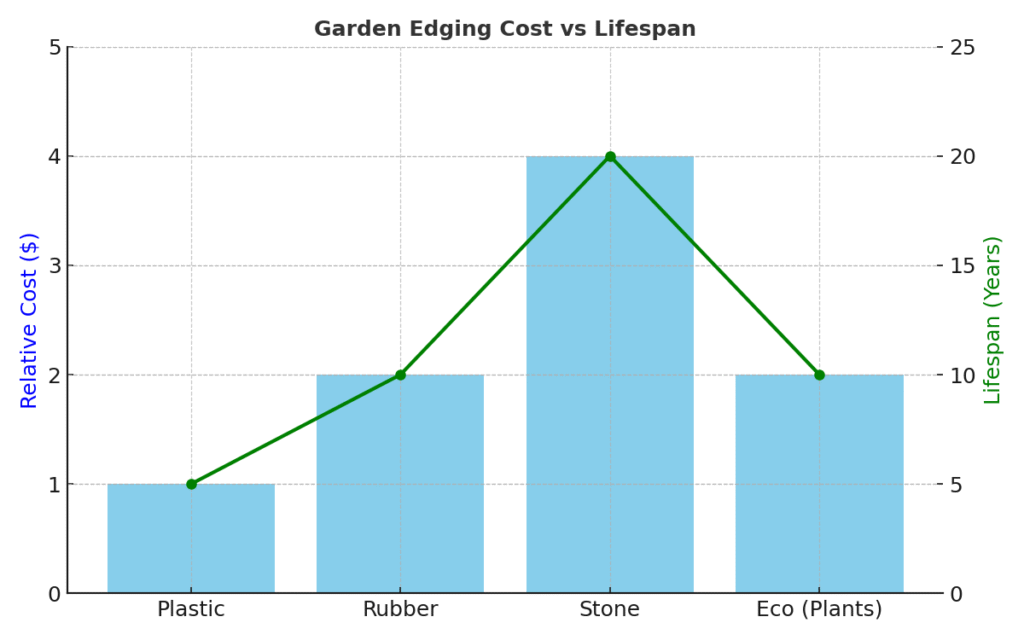
Weather resistance varies significantly by stone type, installation quality, and regional climate conditions. Freeze-thaw cycles can shift improperly set stones in northern climates, requiring seasonal readjustments and occasional complete reinstallation of affected sections.
Proper base preparation minimizes but doesn’t completely eliminate frost movement. Installing 4-6 inches of compacted gravel base beneath stone edging provides stability and drainage that reduces weather-related shifting problems.
➡️ The aesthetic payoff often justifies higher costs for families prioritizing curb appeal and property value. Innovative Lanscape reports that stone borders complement virtually any architectural style while providing timeless appeal that doesn’t appear dated after design trends change.
Regional stone availability affects both costs and design options. Local quarries typically offer better prices on native stone varieties, while imported materials increase costs but provide unique aesthetic options not available locally.
Plastic Garden Edging: Accessible Solutions for Every Budget
Plastic borders provide the most affordable entry point for homeowners wanting clearly defined bed edges without significant financial investment. Roll edging, pound-in strips, snap-together sections, and molded corner pieces offer installation options for different yard layouts and skill levels.
Installation speed makes plastic garden edging appealing for busy weekend warriors. Most plastic types can be installed completely in several hours rather than multiple days, requiring only basic hand tools and minimal ground preparation.
Flexibility advantages become especially apparent around curved flower beds and irregular landscape shapes. Roll-style plastic edging bends easily to follow natural property contours, while rigid stone materials require cutting, fitting, and custom joining for similar curved applications.
🎨 Color options allow coordination with existing landscape elements. Black plastic virtually disappears against dark mulch, while brown options complement natural wood chips and earth tones commonly used in family-friendly landscapes.
Maintenance requirements remain minimal throughout growing seasons. Occasional re-staking of sections affected by frost-heave or soil settling maintains clean border lines with minimal time investment.
However, longevity concerns significantly affect long-term value calculations for families planning extended homeownership. Standard plastic garden edging typically requires complete replacement every 3-5 years as UV degradation causes cracking, fading, and brittleness that compromises both function and appearance.
Appearance limitations become increasingly noticeable as plastic materials weather and age. New plastic looks clean and purposeful, but weathered plastic can appear cheap or temporary, especially when contrasted against high-end landscaping investments like mature plantings or decorative mulches.
Commercial-grade recycled plastic represents a middle-ground solution that addresses some durability concerns while supporting environmental sustainability. Companies specializing in landscape products produce thicker, more weather-resistant options that maintain appearance longer than standard home improvement store alternatives.
💡 The notorious “popping up” problem frustrates many homeowners attempting lightweight plastic installations. Insufficient burial depth, poor soil compaction, or freeze-thaw cycles cause sections to rise above intended ground level, requiring frequent readjustment and maintenance attention.
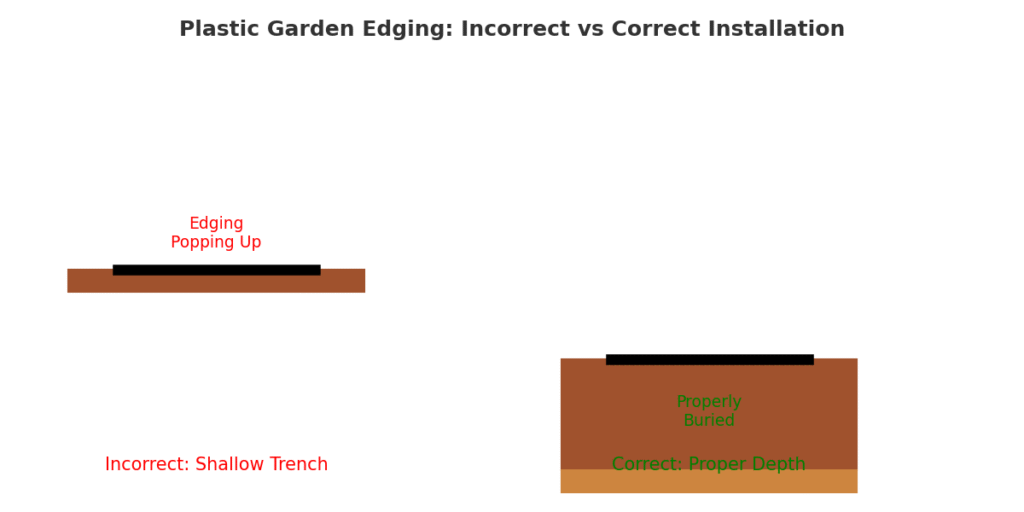
Weight considerations affect installation success and long-term stability. Heavier plastic materials stay positioned better but require more effort during installation, while lightweight options install easily but may shift seasonally.
Cost effectiveness makes plastic garden edging attractive for temporary applications, rental properties, or families testing bed layouts before investing in permanent solutions. The ability to relocate or modify plastic borders provides flexibility that stone installations cannot match.
Eco-Friendly Garden Edging: Sustainable Solutions That Work
Environmental consciousness increasingly drives family landscaping decisions, and sustainable border options reflect this growing awareness. Recycled materials, living plant borders, and reclaimed wood provide attractive alternatives to traditional manufactured plastic and quarried stone.
Recycled rubber borders combine environmental responsibility with practical durability. Manufactured from repurposed tires, these products resist UV degradation and weather damage better than standard plastic while diverting substantial waste from landfills.
Living borders represent the ultimate eco-friendly garden edging approach. Low-growing herbs like creeping thyme, ornamental grasses such as liriope, or compact perennials create natural edges that change seasonally while providing additional landscape benefits.
🌿 Creeping thyme works exceptionally well in sunny, well-drained locations, creating fragrant purple carpet borders that tolerate moderate foot traffic while attracting beneficial pollinators. I planted thyme borders around our raised vegetable garden three years ago — the results still exceed expectations for both beauty and functionality.
Reclaimed wood and natural log rolls offer rustic charm while repurposing materials that might otherwise contribute to construction waste. Cedar naturally resists decay and insect damage, while pressure-treated reclaimed lumber provides longevity in challenging soil and weather conditions.
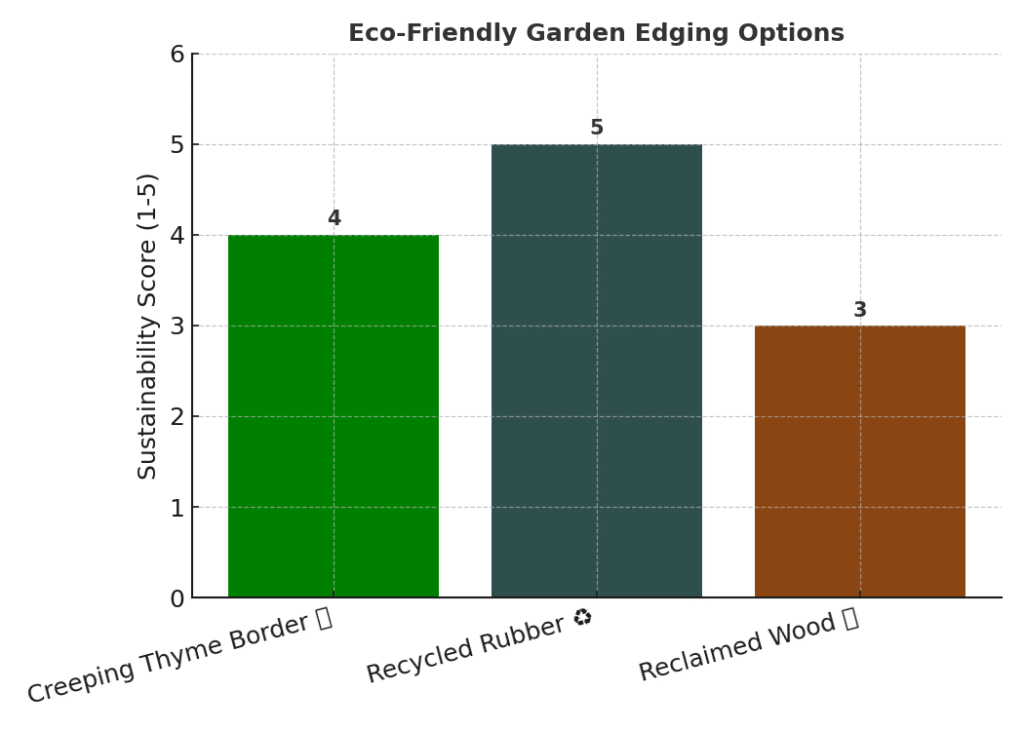
Installation considerations vary dramatically between different eco-friendly options. Living borders require ongoing maintenance similar to any planted landscape area, while reclaimed wood installations need proper anchoring and drainage to prevent shifting and premature deterioration.
Cost comparisons often favor eco-friendly choices over traditional manufactured materials. Establishing living plant borders costs primarily labor time and initial plant purchases, while recycled rubber pricing typically falls between basic plastic and premium stone options.
Environmental impact benefits extend beyond responsible material sourcing. Living borders actively support local ecosystems by providing wildlife habitat, supporting pollinators, and eliminating manufacturing and transportation carbon footprints associated with traditional materials.
📌 However, eco-friendly garden edging doesn’t suit every landscaping situation or maintenance preference. Living borders perform poorly in heavily shaded areas where plants cannot establish properly, and high-traffic zones may damage delicate plantings.
Seasonal appearance changes characterize living borders — some homeowners appreciate dynamic seasonal interest while others prefer consistent year-round appearance provided by manufactured materials.
Professional Installation Techniques for Long-Term Success
Proper site preparation ultimately determines installation success regardless of which border material you select. Ground preparation consistently makes the difference between edges that maintain professional appearance for years versus borders that shift, sink, separate, or fail within the first growing season.
Begin every installation by accurately marking desired border lines using spray paint, garden hoses, or marking flags. This crucial step prevents expensive mistakes while allowing complete visualization of final results before committing tools and materials to permanent placement.
➡️ Excavation depth requirements depend on chosen materials but most effective installations require trenches 4-6 inches deep to ensure adequate stability and prevent seasonal movement. Shallow installation virtually guarantees future problems with shifting, popping up, or separation.
Soil compaction in trench bottoms prevents gradual settling that creates uneven, unprofessional-looking borders over time. Firmly tamping loose soil before placing materials establishes stable foundations that maintain proper positioning through multiple freeze-thaw cycles.
Common installation mistakes include:
• Inadequate joint overlap
• Insufficient backfilling
• Poor drainage consideration
• Rushed timeline without proper planning
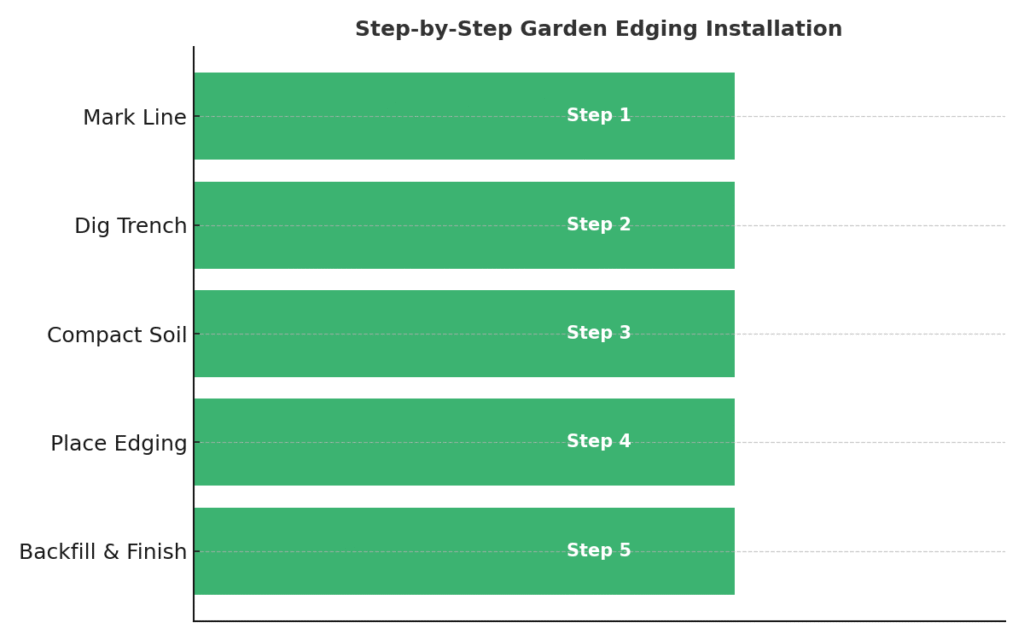
These errors become apparent quickly through visible gaps, noticeable shifting, or water pooling against materials that creates soggy soil conditions.
Tool requirements vary by material selection but generally include shovels, levels, rubber mallets, and wheelbarrows for transporting materials efficiently. Stone installations demand additional equipment including tampers, string lines for alignment, and sometimes concrete or polymer sand for securing irregular pieces.
Weather timing significantly affects installation success and long-term performance. Avoid installation during wet soil conditions when proper compaction becomes impossible, and schedule concrete work during moderate temperatures when materials cure properly according to manufacturer specifications.
🔧 Quality control measures during installation prevent costly corrections later. Check level and alignment frequently, test all joint connections for gaps, and verify proper drainage flow before completing backfill operations around new borders.
For families new to DIY projects, these time-saving tips can help streamline the installation process while maintaining quality results.
Creative Design Ideas That Elevate Ordinary Yards
Curved border lines create significantly more visual interest than straight geometric edges, particularly around larger mature trees or expansive island beds. Natural flowing curves complement most residential landscaping styles more effectively than rigid linear patterns that can appear institutional.
Material mixing produces striking design results when executed thoughtfully rather than randomly. Combining natural stone with planted living borders, or using thin metal strips to separate different colored mulch zones, creates sophisticated layered designs that photograph beautifully.
Height variation adds essential visual dimension to otherwise flat landscape designs. Slightly raised stone borders or multi-level plantings behind primary edging create depth and interest that dramatically improves curb appeal while providing practical benefits like improved drainage.
Color coordination between materials and existing landscape elements creates cohesive designs that appear professionally planned. Consider your home’s exterior paint colors, existing hardscaping materials, and dominant seasonal plant colors when selecting materials and installation patterns.
💡 Lighting integration transforms functional borders into evening focal points that extend landscape enjoyment beyond daylight hours. Solar stake lights positioned behind edges, LED strip lighting concealed within stone borders, or strategic landscape spotlights can highlight borders after dark.
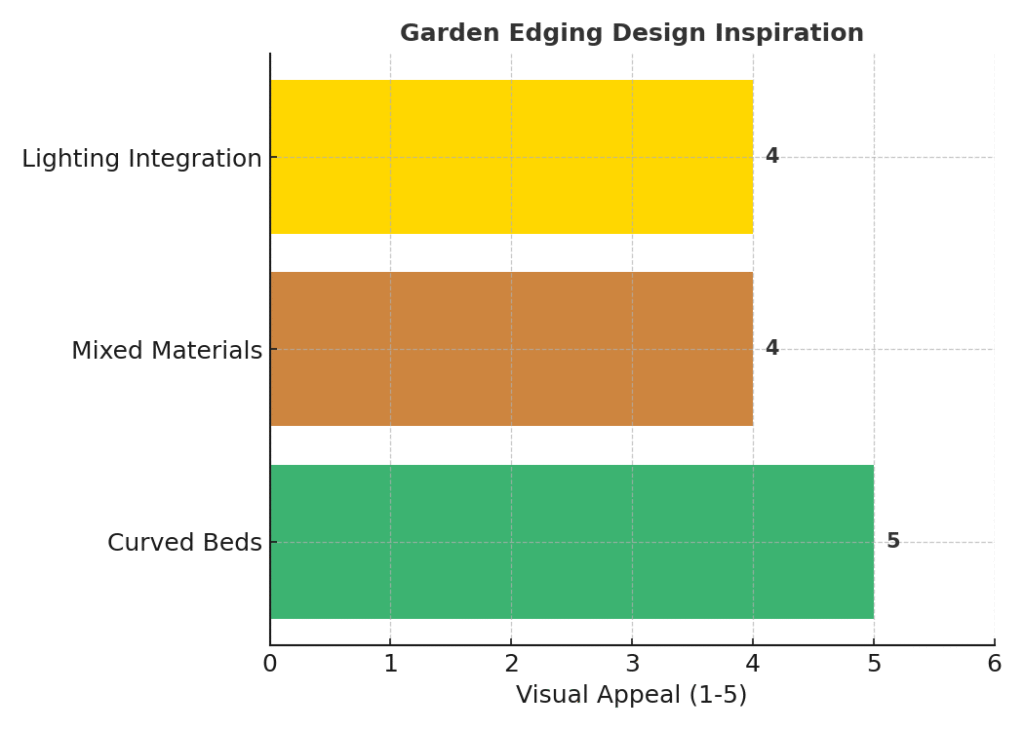
Seasonal interest planning keeps designs attractive throughout dormant months when deciduous plants lose visual impact. Incorporating evergreen plants, ornamental grasses with winter structure, or decorative stone accents ensures borders maintain intentional appearance year-round.
Scale proportions prevent edging from overwhelming smaller landscape spaces or appearing insignificant within larger yard designs. Match height, width, and visual weight to existing bed proportions and overall landscape scale for balanced, professional results.
Transition zones between different landscape areas benefit from coordinated treatments that guide visual flow while maintaining distinct functional areas. Consistent materials or complementary color schemes help unify disparate landscape elements into cohesive overall designs.
Detailed Material Comparison: What Works Where
Different border materials excel in specific applications while performing poorly in others. Understanding these performance characteristics helps match materials to individual landscape needs and family maintenance preferences.
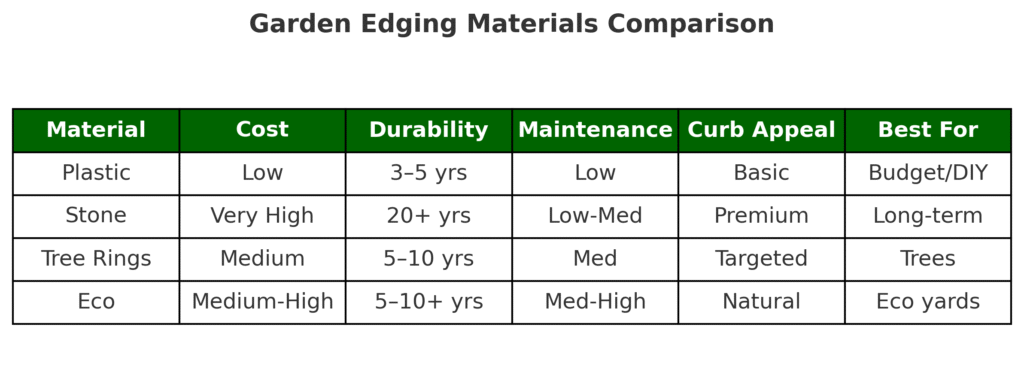
Drainage requirements significantly influence material selection success. Stone and gravel provide excellent drainage for plants requiring well-drained soil conditions, while plastic materials may impede water movement in heavy clay soils.
Soil type compatibility affects installation ease and long-term stability:
• Sandy soils drain well but provide less structural support for heavy stone installations
• Clay soils support weight better but may heave plastic during freeze-thaw cycles
• Loamy soils offer ideal conditions for most border materials
Maintenance accessibility influences practical material choices for busy families. Garden edging installed in easily reached locations can utilize materials requiring occasional adjustment, while remote or difficult-access areas benefit from maintenance-free stone or living border options.
Installation skill requirements vary dramatically between material types. Plastic forgives minor installation imperfections while stone requires precision leveling and alignment for professional appearance.
🌡️ Climate considerations affect material performance and replacement schedules. Extreme temperature variations, UV exposure levels, and precipitation patterns all influence how different materials age and maintain appearance over time.
Budget flexibility allows phased installation approaches where premium materials accent high-visibility areas while cost-effective options handle utility zones. Most families achieve better overall results by varying materials strategically rather than attempting uniform premium installations within limited budgets.
Advanced Installation Tips from Real-World Experience
Proper depth calculation prevents most common installation failures that result in shifting, separation, or premature material failure. Measure from final grade level rather than existing ground to account for mulch addition and soil settling.
Base material preparation varies by type but consistently affects long-term stability. Compacted gravel bases work well for stone installations, while sand leveling helps achieve consistent height for manufactured products.
Joint treatment determines whether installed borders maintain clean lines or develop visible gaps over time:
• Overlapping plastic sections by 2-3 inches prevents separation
• Stone installations benefit from tight-fitting joints or mortar application
• Living borders require proper plant spacing for natural coverage
Slope management becomes critical for installations on anything other than perfectly level ground. Water naturally flows toward low points, potentially undermining materials or creating soggy soil conditions that damage plants.
Anchoring methods prevent displacement during routine landscape maintenance activities. Stakes, buried flanges, or interlocking design features keep materials positioned properly when subjected to mower impacts or foot traffic.
📅 Seasonal adjustment planning helps maintain professional appearance through weather-related ground movement. Spring inspection and minor repositioning address winter frost damage before growing season begins.
Tool investment for DIY installation can range from basic hand tools for simple plastic projects to specialized equipment for complex stone installations. Borrowing or renting specialized tools often proves more cost-effective than purchasing equipment for one-time projects.
Quality control checkpoints during installation prevent expensive corrections after project completion. Verify level, alignment, and drainage flow before backfilling operations make adjustments difficult or impossible.
Budget-Conscious Strategies for Maximum Impact
Strategic material allocation helps families achieve professional landscaping results within realistic budget constraints. Premium materials work best in high-visibility front yard locations while cost-effective options handle less prominent backyard utility areas effectively.
Phased installation approaches spread costs across multiple seasons while allowing families to test material preferences and installation techniques on smaller projects before committing to whole-yard renovations.
DIY installation versus professional services presents trade-offs between time investment and guaranteed results:
• Simple plastic installations work well for weekend DIY projects
• Complex stone installations may justify professional expertise
• Living borders require patience but minimal technical skill
Material sourcing strategies can significantly reduce project costs without compromising quality. Local quarries often provide better stone prices than retail landscaping centers, while end-of-season sales offer substantial savings on manufactured products.
💰 Combination approaches maximize both budget efficiency and aesthetic impact. Using premium stone for front entrance focal points while installing practical plastic borders in less visible areas achieves professional overall appearance within modest budgets.
Maintenance cost considerations affect long-term budget planning for different materials. While stone requires higher upfront investment, minimal ongoing maintenance costs may provide better long-term value than repeatedly replacing cheaper plastic alternatives.
Seasonal timing affects both material availability and installation conditions. Spring and fall typically offer ideal weather conditions for outdoor projects while providing access to seasonal sales and contractor availability.
For families managing tight budgets, these home cleaning tips demonstrate how small improvements can make significant visual impact — the same principle applies to strategic landscaping investments.
Common Installation Mistakes and How to Avoid Them
Inadequate excavation depth causes the majority of failures within the first year after installation. Homeowners frequently underestimate depth requirements, resulting in edging that shifts, separates, or becomes displaced during routine maintenance.
Poor drainage planning creates long-term problems for both materials and adjacent plantings. Water pooling against improperly installed borders can cause frost damage, material deterioration, and root rot in nearby plants.
🚨 Incorrect spacing around trees represents a serious long-term mistake that can compromise tree health and require expensive correction. Installing tree ring edging too close to trunk bases restricts natural root flare development and creates moisture retention problems.
Joint treatment negligence leads to visible gaps and material separation that destroys professional appearance. Plastic sections require adequate overlap and secure connections while stone installations benefit from tight fitting or mortared joints.
Rushing installation without proper planning consistently produces subpar results that require correction or complete reinstallation. Taking time for accurate measurement, material calculation, and tool preparation prevents costly mistakes and wasted materials.
Soil condition ignorance affects material selection and installation success:
• Heavy clay soils may heave lightweight plastic during freeze-thaw cycles
• Sandy soils may not provide adequate support for heavy stone without proper base preparation • Compacted soils require additional preparation for proper drainage
Seasonal considerations influence installation timing and long-term performance. Installing garden edging during wet conditions or extreme temperatures can compromise material performance and installation quality.
Tool inadequacy leads to frustration and poor results. Using inappropriate tools for specific materials — such as attempting to cut stone with inadequate equipment — creates safety hazards while producing unprofessional appearance.
According to This Old House installation guides, proper tool selection and technique prevent 90% of common installation problems that plague DIY projects.
Professional Maintenance Strategies for Extended Lifespan
Seasonal inspection routines keep all border types functioning optimally while identifying minor problems before they require expensive corrections. Spring assessments reveal winter damage while fall preparations extend material life through harsh weather periods.
Stone maintenance involves periodic re-leveling as natural frost action and soil settling gradually shift individual pieces out of proper alignment. This seasonal maintenance typically requires lifting affected stones, adding base material as needed, and repositioning for correct height and spacing.
Plastic material maintenance focuses on UV damage assessment and replacement planning. Regular inspection helps identify sections showing brittleness, cracking, or significant color fading that indicate approaching replacement needs.
Living border maintenance resembles standard garden care requirements:
• Regular weeding to maintain clean lines
• Seasonal pruning to control growth
• Occasional replanting as plants mature or environmental conditions change
Time investment varies significantly by plant selection and growing conditions specific to each installation location.
🧽 Cleaning requirements differ substantially between materials. Natural stone can withstand power washing or scrubbing to remove algae, moss, and accumulated debris, while plastic materials may crack or discolor under high-pressure cleaning methods.
Replacement timeline planning helps families budget appropriately for future landscape maintenance and improvements. Plastic typically needs replacement every 3-7 years, quality stone installations can function indefinitely with proper maintenance, and living borders may require replanting every 5-10 years depending on plant species selection.
Documentation of installation details proves valuable for future maintenance and replacement planning activities. Photographs showing installation depth, material sources, and design details help when problems arise years later or when expanding borders to additional landscape areas.
Preventive maintenance costs significantly less than correction or replacement. Regular attention to minor shifting, settling, or damage prevents small problems from developing into expensive landscape failures requiring complete reinstallation.
Material-Specific Pros and Cons Analysis
Stone advantages include exceptional durability, premium appearance, and property value enhancement. Natural materials complement virtually any architectural style while providing timeless appeal that doesn’t appear dated as design trends evolve.
Stone disadvantages involve higher material costs, intensive installation labor, and potential frost movement in northern climates. Weight considerations make stone difficult to relocate if landscape designs change or families move to different properties.
Plastic benefits include affordable material costs, flexible installation around curves, and easy modification or relocation as landscape needs evolve. Lightweight materials allow single-person installation without requiring family members or hired assistance for heavy lifting.
📊 Plastic limitations encompass shorter lifespan, potential appearance degradation, and reduced property value impact compared to premium alternatives. UV exposure gradually weakens most plastic materials regardless of initial quality or manufacturer warranties.
Tree ring benefits include targeted protection for valuable mature trees while creating defined mulch zones that enhance individual tree appearance. Installation around existing trees requires minimal landscape disruption compared to bed border projects.
Tree ring limitations include sizing constraints, potential drainage problems, and appearance issues around young trees that haven’t developed proportionate canopies. Improper installation can actually harm tree health by creating moisture retention or restricting natural root development.
Eco-friendly options offer environmental benefits and unique aesthetic appeal while often providing cost advantages over manufactured alternatives. Living borders support local wildlife while eliminating manufacturing environmental impacts.
Eco-friendly disadvantages may include higher maintenance requirements and variable performance depending on growing conditions, plant establishment success, and seasonal weather patterns affecting plant health.
Regional Climate Considerations for Material Selection
Northern climate challenges affect all materials through freeze-thaw cycles that can shift, crack, or heave improperly installed borders. Material selection and installation techniques must account for significant seasonal ground movement.
Stone installations in cold climates benefit from deeper base preparation and adequate drainage to minimize frost damage. Proper base depth and gravel drainage reduce but don’t eliminate seasonal movement that may require spring adjustments.
Plastic materials become brittle in extreme cold, increasing susceptibility to cracking from impact or ground movement. Flexible plastic garden edging performs better in cold climates than rigid alternatives that may shatter during temperature extremes.
🌞 Southern climate considerations include intense UV exposure that accelerates plastic degradation and extreme heat that can make some materials uncomfortable to handle during installation or maintenance.
Drainage requirements vary significantly by regional precipitation patterns and soil types common to different geographic areas:
• Areas with heavy clay soils and high rainfall need different drainage solutions
• Arid regions with sandy soils require moisture retention considerations
• Coastal areas face salt exposure challenges
Plant hardiness zones affect living border success when using eco-friendly approaches. Regional native plants typically perform better than exotic species requiring additional water, fertilizer, or protection from local climate extremes.
Seasonal installation windows vary by climate zone. Northern regions have shorter optimal installation periods, while southern areas may need to avoid extreme summer heat for comfortable working conditions and proper material curing.
Local building codes and HOA restrictions may influence material choices and installation requirements in some residential areas. Checking regulations before beginning projects prevents conflicts and potential correction requirements.
Expert Tips for Choosing the Perfect Solution
Assessment of existing landscape elements guides appropriate material selection for cohesive overall design results. Consider architectural style, existing hardscaping materials, and dominant plant characteristics when evaluating options.
Maintenance capacity realistic evaluation helps prevent selection of beautiful options that become ongoing burdens rather than landscape assets. Honest assessment of available time and physical ability for seasonal maintenance prevents poor material choices.
Budget planning should include both initial material costs and long-term maintenance or replacement expenses. Total cost of ownership over 10 years provides more accurate comparison between different alternatives.
💡 Family safety considerations become paramount with children and pets using outdoor spaces regularly. Avoid sharp metal near play areas, ensure stone installations don’t create tripping hazards, and consider rounded edges for high-traffic pathways.
Professional consultation may justify costs for complex installations or expensive material investments where mistakes prove costly to correct. Landscape professionals can provide design guidance and installation expertise that prevents expensive errors.
Testing approaches work well for families uncertain about material preferences or installation techniques. Installing small sample sections allows evaluation of appearance, maintenance requirements, and performance before committing to large-scale projects.
Design flexibility planning considers future landscape changes and family needs evolution. Materials and installation techniques that accommodate modifications work better for growing families than permanent solutions requiring complete replacement for changes.
Property value impact varies by neighborhood standards and regional preferences. Research local real estate trends and comparable property landscaping before investing in premium materials for maximum return on investment.
For new homeowners, this comprehensive guide provides valuable context for prioritizing landscaping investments within broader home improvement planning.
Troubleshooting Common Problems
Shifting and separation issues frequently result from inadequate installation depth or poor soil preparation during initial installation. Most plastic problems can be prevented by deeper burial and proper soil compaction.
Drainage problems manifest as water pooling against materials or soggy soil conditions that stress nearby plants. Proper grade management and drainage gaps prevent most water-related issues while maintaining clean border appearance.
Weed growth along lines occurs when installation gaps allow grass and weeds to penetrate border areas:
• Tight joint connections minimize weed establishment
• Adequate burial depth prevents root penetration
• Pre-emergent herbicide application provides additional protection
Material degradation varies by type but consistently results from UV exposure, temperature extremes, or chemical soil conditions. Regular inspection identifies degradation early when partial repairs remain possible rather than requiring complete replacement.
🔧 Seasonal adjustment requirements affect most installations to some degree. Spring repositioning addresses frost damage while fall preparation protects materials through winter weather extremes.
Height inconsistencies develop gradually as soil settles or materials shift seasonally. Maintaining consistent height requires periodic adjustment using additional base material or repositioning techniques specific to each material type.
Color fading affects plastic and some stone materials over time. UV-resistant materials delay but don’t prevent gradual color changes that may require replacement for maintained appearance standards.
Plant growth interference can occur when living borders or adjacent plantings outgrow intended spacing. Regular pruning and selective removal maintain intended border definition while preventing overcrowding that compromises both plants and effectiveness.
Garden maintenance experts on Reddit frequently discuss troubleshooting techniques and seasonal adjustment strategies that help homeowners maintain professional-looking borders year-round.
Long-Term Planning and Future Modifications
Landscape evolution planning helps families select materials that accommodate changing needs as children grow, family interests develop, and property improvements progress over time.
Modification flexibility varies dramatically between different material choices. Plastic can be relocated, extended, or reconfigured relatively easily, while stone installations represent essentially permanent landscape commitments.
Property value timing considerations influence material selection for families planning to sell within specific timeframes. Premium materials may provide better return on investment for families staying long-term, while practical options work better for shorter ownership periods.
➡️ Growth accommodation planning becomes essential around young trees that will significantly increase in size over coming decades. Tree ring edging must allow for substantial trunk diameter increases without requiring complete reinstallation as trees mature.
Future maintenance accessibility affects practical material choices for aging homeowners or families with changing physical capabilities. Materials requiring periodic heavy lifting or precise adjustments may become problematic over time.
Technology integration possibilities include smart irrigation connections, lighting systems, or monitoring equipment that may require modifications. Planning for potential technology additions prevents conflicts with permanent installations.
Expansion planning helps install systems that can be extended logically as landscape projects progress. Consistent material selection and installation techniques facilitate seamless additions that maintain professional overall appearance.
For families prioritizing safety alongside aesthetics, these home safety tips demonstrate how landscaping choices impact overall family security and well-being.
Final Recommendations for Success
The most successful projects balance ambitious aesthetic goals with realistic maintenance capabilities and budget constraints. Start with smaller test areas to evaluate your chosen materials and installation approach before committing to comprehensive yard-wide installations.
After experimenting with various approaches across multiple homes and climate zones, I’ve discovered that success comes from matching specific materials to individual location requirements rather than applying universal solutions to diverse landscape challenges.
Our current property successfully combines multiple approaches — natural stone around the front entrance for maximum curb appeal, practical plastic borders along utility areas, and living thyme borders around raised vegetable gardens that provide both function and fragrance.
🏠 Consider your family’s realistic long-term plans when selecting materials and installation complexity. Permanent stone solutions make sense for forever homes, while flexible alternatives work better for military families or others expecting future relocations.
Remember that functional beauty beats elaborate complexity every single time. Choose options that enhance your daily outdoor enjoyment while fitting comfortably within your maintenance schedule and budget reality.
Home improvement projects succeed when they solve real problems rather than creating additional maintenance burdens. The satisfaction of crisp, well-maintained bed borders far outweighs the initial effort required for proper installation.
Perfect doesn’t exist in family landscaping — functional and attractive consistently beats elaborate but unsustainable approaches. Choose garden edging that supports your family’s outdoor lifestyle while providing the visual appeal and practical benefits that make yard maintenance easier rather than more complicated.
Quality installation techniques matter more than expensive materials. Properly installed plastic garden edging outperforms poorly installed stone in both appearance and longevity, so invest time in learning correct installation methods regardless of material selection.
💡 The best borders enhance your property without creating ongoing stress about maintenance, replacement costs, or seasonal adjustments. When garden edging fits seamlessly into your routine yard care, you know you’ve made the right choice for your family’s specific needs and circumstances.
For families managing multiple home improvement priorities, these organizational strategies help prioritize projects and maintain momentum while juggling busy family schedules.
Explore More from Our Family of Blogs
Mountains Will Move
Faith-based encouragement for everyday families.
Everyday Exposed
No-filter truth hub for critical thinking and clarity.
Thank you for being part of the community. God Bless you and your family.